I had been to Incheon before—once for a baseball game (the hometown SK Wyverns vs. the Nexen Heroes) at Munhak Stadium, once to visit friends and once to join a group catching a ferry up to Baengnyeong Island. But those were just brief visits in which I did not see much. In light of the fact that this is 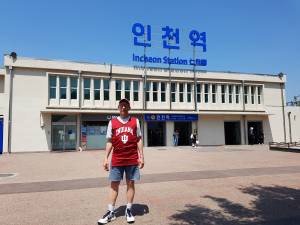 Korea’s third-largest city with more than 3 million residents, I really needed to go back and take a closer look.
Korea’s third-largest city with more than 3 million residents, I really needed to go back and take a closer look.
It would have been possible to ride a bus from Seoul to Incheon, but the distance is just 27 kilometers and the subway goes there. I disembarked at Incheon Station and had no trouble finding a standard-quality hotel barely two blocks away in the heart of Chinatown. Also very convenient was the presence of a tourist booth where I secured an excellent English-language map. It shared space with an office selling tickets to a series of around-the-city buses. Pay 10,000 won and you can go all over Incheon, getting off and back on when you want; buses run every half hour. I did not hesitate to put down my 10K and start exploring.
Incheon is, above all, a port city—second in Korea only to Busan. I saw gigantic ships entering and leaving the harbor, not to mention silos, warehouses, seemingly thousands of metal containers, and row upon row of Hyundais and Kias ready to be sent overseas. These days, it’s completely modern and mechanized. But in 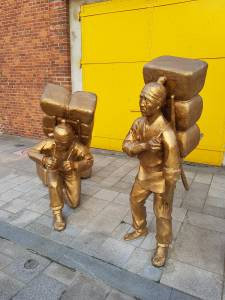 the 1880s, when Britain, Germany, the USA, China and Japan essentially forced Korea to end its self-imposed isolation, all along the waterfront short but tightly muscled men hauled cargo to and from ocean-going vessels with wooden A-frames strapped to their backs. These “coolies” worked from dawn to dusk.
the 1880s, when Britain, Germany, the USA, China and Japan essentially forced Korea to end its self-imposed isolation, all along the waterfront short but tightly muscled men hauled cargo to and from ocean-going vessels with wooden A-frames strapped to their backs. These “coolies” worked from dawn to dusk.
After enjoying the sights from the comfort of the air-conditioned bus, I got off at Central Park. I wanted to visit the Incheon City History Museum. On my way there, I met a man wearing a Texas Rangers jersey—specifically, that of right fielder Shin-Soo Choo. You can’t say the Koreans don’t love their own. I also encountered a young man whose job was to direct people seeking to park their cars. He noticed my ROK Army backpack and said he would soon be compelled to start his two years in the military. We briefly discussed Korea’s neo-sexist policy whereby men serve but women stay home and do their nails or whatever. I did reach the museum, and another one later that seemed to duplicate it. They showed Incheon’s evolution from the Paleolithic era to the bustling metropolis of today.
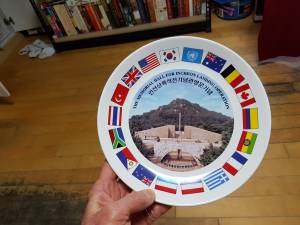 Back on the bus, I traveled to the Memorial Hall for the Incheon Landing Operation. I have already written about Douglas MacArthur, architect of that gutsy military move in the summer of 1950. And I had been to this place with the friends mentioned earlier, so I did not even go in. What I sought was a photo op at the big statue of “the American Caesar,” but I learned that it was elsewhere—in Jayu Park. My visit was not in vain, however, because I happened to meet a Japanese woman named Yuko Tsukiyama. A Tokyo-based lawyer, she was there to deepen her understanding of Korean history. Yuko told me that when she was growing up, the awful realities of the Japanese colonial era were kept from her and other students, and was now
Back on the bus, I traveled to the Memorial Hall for the Incheon Landing Operation. I have already written about Douglas MacArthur, architect of that gutsy military move in the summer of 1950. And I had been to this place with the friends mentioned earlier, so I did not even go in. What I sought was a photo op at the big statue of “the American Caesar,” but I learned that it was elsewhere—in Jayu Park. My visit was not in vain, however, because I happened to meet a Japanese woman named Yuko Tsukiyama. A Tokyo-based lawyer, she was there to deepen her understanding of Korean history. Yuko told me that when she was growing up, the awful realities of the Japanese colonial era were kept from her and other students, and was now 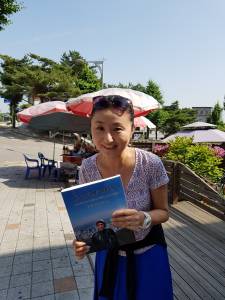 doing her best to compensate. The bus driver kindly waited for me to sign a copy of A Seoul Miscellany and give it to Yuko before I hopped on. We promised to stay in touch.
doing her best to compensate. The bus driver kindly waited for me to sign a copy of A Seoul Miscellany and give it to Yuko before I hopped on. We promised to stay in touch.
My next stop was Sinpo International Market, in existence since the late 19th century. It was big, as you might expect. I had been told to try dakgangjeong, Korean fried chicken coated in a sweet and spicy sauce. But when I saw a photo of it, I demurred and went with a more generic meal of curry and rice. I passed on Wolmi Culture Street, assuming I would visit there the next day. As it turned out, I did not and may never know what I missed.
After completing the 14-stage loop late in the afternoon, I was back at Incheon Station and Chinatown. There is a large gate with Chinese characters (and ubiquitous dragons) leading to numerous streets where the predominant color is red, symbolic of happiness and good luck. I know this is a touristy place, sanitized and monetized and of questionable authenticity. I still enjoyed walking up and down its steep hills, looking at the shops and mingling with other visitors. One street was given over to a huge mural featuring text and scenes from Samgukji, a classic of Chinese literature. High above Chinatown, I found Jayu (“Freedom”) Park and the statue of MacArthur. Close by was a towering artistic representation of U.S−Korean amity, dated 1982. The two countries had established diplomatic relations one century earlier.
On Sunday morning, I checked out of the hotel and was walking into a coffee shop when a man thrust a pamphlet in my hand and told me that Jesus had died for my sins and the other basics of the Christian 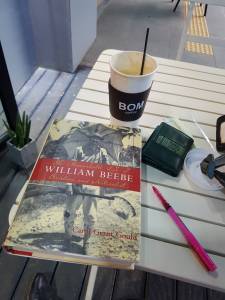 faith. “I know, I know,” I said to him. “Why are you preaching at me? Bug off!” I drank my café latte and read 15 pages of a biography of the intrepid explorer and naturalist William Beebe (1877−1962).
faith. “I know, I know,” I said to him. “Why are you preaching at me? Bug off!” I drank my café latte and read 15 pages of a biography of the intrepid explorer and naturalist William Beebe (1877−1962).
My plan to again ride the tourist bus was aborted since I was in the middle of old Incheon. I savored Chinatown, for all its imperfections. And right around the corner was a two-part facility I could not wait to see: the Korean−Chinese Cultural Center and the Incheon Overseas Chinese History Museum. These promised to be quite interesting, but imagine my dismay when I found that both were under renovation. How eager I was to go through these exhibits! Not to be overly cynical, but I hoped to see whether they would accurately describe the little brother−big brother relationship that obtained for many centuries and how the Chinese still refuse to admit that ancient Goguryeo (more than double the size of present-day North and South Korea) was one of the great powers of East Asia before its defeat in 668. What, I would also like to know, about Mao Zedong’s forces coming to the aid of their fellow commies during the Korean War? Or the Chinese’ sustenance of the ailing economy north of the border? These matters were almost certainly not addressed.
I dropped by a mom-and-pop fruit stand and bought cherries, tangerines and a mango before taking the subway back to Seoul.

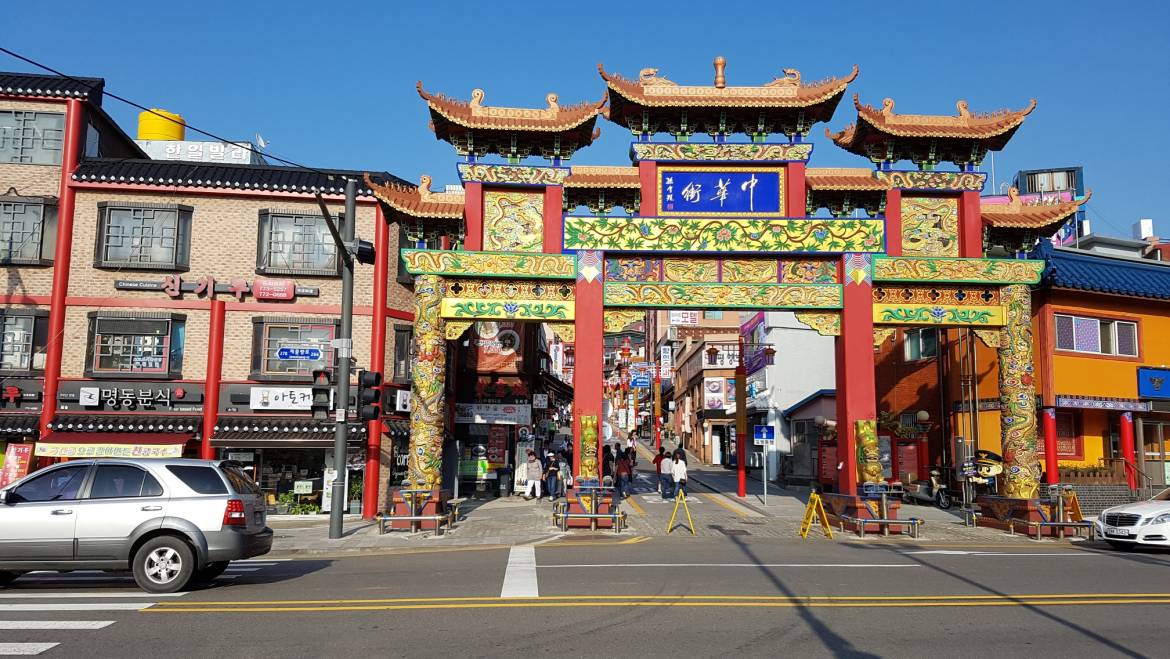
16 Comments
Richard, among the novelties of this city, the most striking observation you had while riding the bus was that as a port city, this is the first time I have heard you mention the Kia automobiles and stock piling of cargo containers. This type of exporting must mean that this city is both steeped in history/tradition but has also been visionary in establishing it’s place as a “trading Center” for global commerce. Other remarks about the gigantic ships entering port coupled with the MacArthur remarks reminds me that the 22 foot tide at the US invasion’s landing spot should somehow also affect the port, but maybe I don’t fully understand the ocean’s influence on the Korean’s ports.
Also, can you comment on the evangelic proselytizer’s appearance that so agitated you, namely unseemly or just too aggressive in their enthusiasm? What exactly turned you off?
Was the Japanese woman’s home Korea or was she in Korea as a business traveler? You seem to select certain people to engage in conversation and sharing copies of your books. If she is an expat business woman, then the book will actually be helpful due to you extensive insights from previous travels.
Thanks for the insights in Incheon!
Gary, thank you for these pertinent comments. You are right about the extreme of high and low tides, which is one reason Mac’s landing was so impressive. I thought I would get bogged down in detail by saying how there are locks and an inner harbor to go with the outer harbor. The proselytizer was just too darn pushy. It was comical to have him do this, and he offended me by the apparent assumption that he was heaven-bound but maybe I was not. Yuko is based in Tokyo and was there just for a visit, soaking up Korean culture and history. She says she envies me.
How come you have precious curioristy to explore other place?
With your actual character, you are not old at all and envy you.
In recent, I feel some down and blue mood and want to travel new place and want to get some fresh mood. I think it is some relation with hormon, menopausal disorder.
I hope to overcome this mood so your incheon trip makes me thinking it over. I want to be free with no responsibility and forgetting myself sometimes.
Ha-Sook: Travel is one of the greatest things we can do for ourselves. I guess that’s why I like to get out on the road as often as possible! Have you been to Incheon??
I am glad you are able to get around in a place where so few people can communicate. You have seen so much in your life, and you have an appreciation of it, as well as a desire to share it. Thank you! Kenneth
Yes….somehow I manage, Kenny!
Great story and information for those who, myself included, have not explored the city!
I like the IU sleeveless shirt haha
I (heart) the Hoosiers!
Sounds like a very interesting place. I picked up a lot through your experience. Great article
Thank you, my dear sir. I have seen more of Korea in the last 10 1/2 years than just about anybody, and I never get tired of it.
Richard:
Very well done with good insights to General MacArthur. I think you should pursue the NY Times, Washington Post, and Chicago Tribune. The quality of your writing is outstanding and they may be interested in publishing your articles.
Rex, thanks so much for taking the time to read this and offer a comment. I value your opinion! Did you see the original MacArthur story? https://www.richardpennington.com/2013/01/deconstructing-macarthur/
As always, you have transported me from Philippines to Korea my dear bro! And yes, incheon is one interesting place. Somedsy, in Gods time i will see RAP in person and hope that he will tour me to these nice places!!😃😁😁
Dr. Cornel, I am gratified to know that I was able, to whatever degree, to show you the life of one Korean city. Travels of an American-Korean (part 2) is not far from completion.
Richard-Thanks so much for the interesting read. I have always been interested in Incheon because of the Korean War history and enjoy getting first hand information and your informed views. Cheers-Kevin
Kevin, most Americans know at least one thing about the Korean War–Mac’s Incheon Landing of October 1950. Very significant….
Add Comment